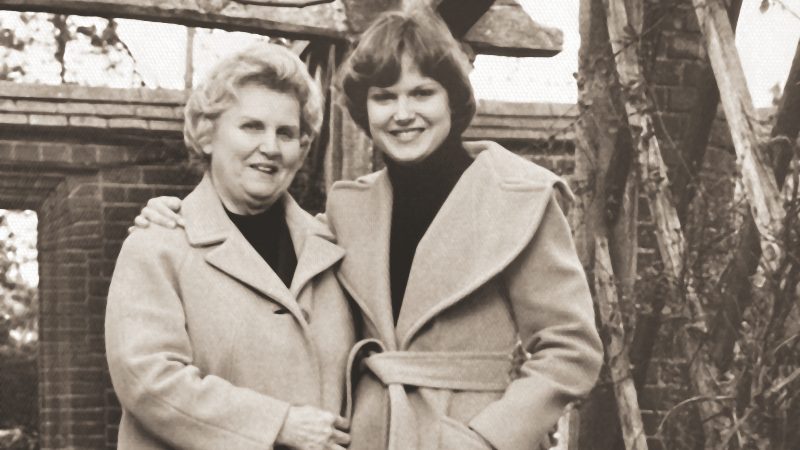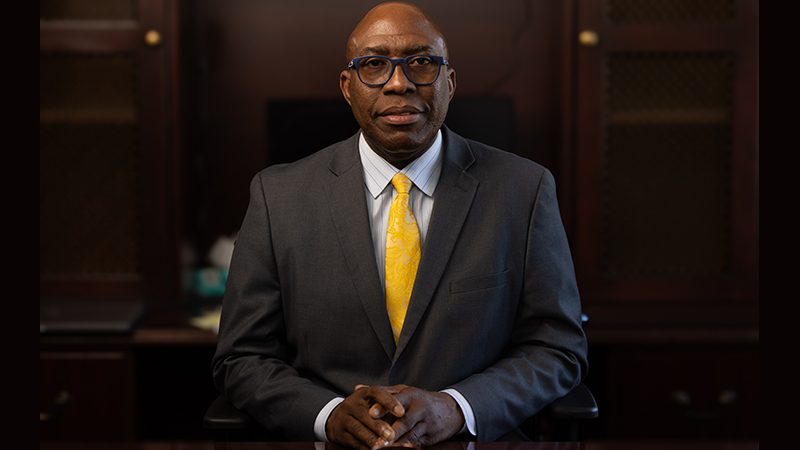Why are boys so mean?” “The football teams you picked are unfair. Can you redo them?” “I think Susie’s mad at me. What should I do?” The questions poured fast and furious out of my pen. One of the weekly assignments in fifth grade, alongside handwriting and spelling lessons, was to submit a “newspaper”—a simple, three-column blank sheet that we could fill with whatever we wanted. Current events, sports scores, a weather report—it was all fair game in Ms. Jackee’s eyes and gradebook.


I decided to create an advice column and used it as an opportunity to mine my beloved teacher’s heart for words of wisdom and sage counsel. She dutifully wrote back every single week and took each preteen, angst-filled question seriously, crafting her replies in such a way that they always nudged me toward the high road and encouraged me to see the bigger picture.
We continued writing back and forth even after I moved on from her classroom and the guise of the newspaper assignment had long disappeared. When I was in academy, we drafted my younger brother, still at the elementary school, to be the messenger. When I came home from school, I’d pounce on his backpack, sift through crumpled papers and soggy sandwiches, and fish out a note from Ms. Jackee. Immediately after reading her letter—sometimes a few sentences, sometimes paragraphs long—I’d write back to tell her all about my week, my teachers, my classes and entrust the folded response back into my brother’s care with stern instructions to deliver it straight into her hands the next day.
In many ways, that experience with Ms. Jackee—one that I look fondly back on now 25 years later—epitomizes my years in Adventist education. My teachers were all brilliant educators who treated me with patience and kindness, grace and respect and invested themselves in me. In this awkward child of immigrant parents, they saw a spark and fanned it into flames of confidence and self-assurance and maturity. From elementary school (Simi Valley Adventist School) to physics and P.E. (Newbury Park Academy) to music history (La Sierra University), my teachers were not only consummate experts in their subject domain, they were also masters in the art of mentorship. They taught me how to balance chemical equations (David Pennock), write a clean research paper with arguments and counterarguments (Tracy Harder), and identify wildflowers (Stan Mulder). I learned about compound interest (Harold Crook), Paul’s letters (Joelle Reed), and all the shortcuts in Word Perfect (Dennis McKenzie). My Adventist education enabled me to win a coveted Bank of America scholar award, and my SAT and ACT scores garnered me entrance to several top universities. But more than that, the messages that I heard over and over and over from my teachers at every Adventist institution I attended were that I was loved, I had value, I was a child of God, and I would do great things for Him.


I began my college studies as a music/pre-medicine student and endured 8 a.m. general chemistry classes that first quarter. When I came home for Christmas break, I tackled the long overdue task of cleaning out some of the old files in my bedroom and unearthed the faded “newspapers” that I’d carefully saved. As I lost myself in reading through my teacher’s thoughtful missives to me, I was amazed at how carefully she treated my fragile feelings, how importantly she seemed to regard each of my dramatic concerns. And I decided right then that I wanted to do the same for other students—I wanted to gift them with what my teachers had given me. I returned to La Sierra University in January and headed straight for the registrar’s office to change my major.
I’ve taught at the elementary, secondary, and university levels for just about two decades now, and in each of my roles, I’ve endeavored to hold true to that original vow to—like my teachers before me—invest in my students’ academic, emotional, and spiritual growth. And that, I’d like to think, is the beautiful and immensely profound contribution of Adventist education.
For those of us who have been members of the Seventh-day Adventist Church all our lives, it is easy to become indifferent or, worse, dismissive of our schools’ commitment to wholistic education. We take for granted or feel entitled to high-quality instruction provided by dedicated teachers. We bemoan the price of tuition and demand evidence for how those dollars are being spent.


While I fully support fiscal accountability and best curriculum practices in our schools, I beseech parents to evaluate the measuring stick they are using to make a decision about their child’s education. The hours spent in a classroom are devoted not only to a child’s academic foundation, but also to…everything else.
I recently wrote a book (Thriving: Stories of the Adventist Education Effect, in press) featuring stories about individuals who credit their professional and personal success to Adventist education. I connected with people who had graduated from various Adventist schools across the country—Monterey Bay Academy, Shenandoah Valley Academy, Upper Columbia Academy, and Pine Forge Academy, to name a few—and were now working in their chosen field, from healthcare to real estate to the arts. And while their stories were unique to each particular context, a theme that quickly emerged from my conversations with them was that the most profound and most influential aspect of their education was not the number of computers in the classroom or the shiny gym equipment or the most up-to-date textbooks but, rather, the everything else.
They talked about the relationships they formed and the identity they developed within an environment that affirmed and nurtured them. They shared of teachers who had dedicated their lives to mentoring teenagers, who generously doled out wisdom, food, money for laundry, and time. They reminisced about life-changing Bible camps, band tours, mission trips, and bonfire vespers. They recalled dormitory deans, librarians, and maintenance staff who modeled Christian living and a vibrant faith. Through laughter and tears, these successful adults with impressive résumés and amazing life experiences told me how they’d achieved their accomplishments and were blessed beyond measure because they’d been pushed, encouraged, guided, and prayed over while in an Adventist school.

I marveled at how closely my story echoed theirs—because I, too, am a product of Adventist education. I, too, would not be who I am today were it not for a system that weaves together outstanding teachers, a standard of excellence, a shared set of beliefs and values, and a Biblical worldview. For decades, Adventist education has provided a space for children to be educated academically within a framework of God’s love and grace. There is simply no better approach for a meaningful and worthwhile school experience.
_____________________________
Aimee Leukert is associate director for the Center for Research on K-12 Adventist Education at La Sierra University.
El «todo lo demás» de la educación adventista
Por Aimee Leukert
Por qué los niños son tan malos?» «Los equipos de fútbol que formaste son disparejos. ¿Podrías rehacerlos?» «Creo que Susie está enojada conmigo. ¿Qué debo hacer?» Las preguntas surgieron rápida y furiosamente de mi pluma. Una de las tareas semanales en quinto grado, junto con lecciones de escritura a mano y ortografía, era hacer un «periódico», una sencilla hoja en blanco de tres columnas que podíamos llenar con lo que quisiésemos. Eventos actuales, resultados deportivos, un informe meteorológico: todo era válido a los ojos y al libro de calificaciones de la Sra. Jackee.


Decidí crear una columna de consejos y la usé como una oportunidad para extraer del corazón de mi amada maestra palabras de sabiduría y sabios consejos. Ella obedientemente me respondía cada semana y tomaba en serio cada pregunta de la angustiada preadolescente, elaborando sus respuestas de tal manera que siempre me llevaban hacia el mejor sendero y me animaban a ver el panorama general.
Nos seguimos escribiendo incluso después de que me mudé de su aula y la tarea de la especie de periódico había desaparecido hacía mucho tiempo. Cuando estaba en la academia, reclutamos a mi hermano menor, todavía en la escuela primaria, para que fuese el mensajero. Cuando llegaba a casa de la escuela, me abalanzaba sobre su mochila, revisaba papeles arrugados y restos de sándwiches, y tomaba la nota de la Sra. Jackee. Inmediatamente después de leer su carta, a veces unas cuantas frases, a veces largos párrafos, le escribía para contarle todo sobre mi semana, mis maestros, mis clases y confiaba la respuesta puesta al cuidado de mi hermano con instrucciones severas de entregarla directamente a las manos de la Sra. Jackee al día siguiente.
En muchos sentidos, esa experiencia con la Sra. Jackee —que recuerdo con cariño 25 años después—, personifica mis años en la educación adventista. Mis maestros fueron todos educadores brillantes que me trataron con paciencia y amabilidad, gracia y respeto e invirtieron en mí. En esa niña torpe de padres inmigrantes, vieron una chispa y la avivaron en llamas de confianza, seguridad en sí misma y madurez. Desde la escuela primaria (Simi Valley Adventist School) hasta física y educación física (Newbury Park Academy) hasta la historia de la música (La Sierra University), mis maestros no solo eran expertos consumados en su dominio de la materia, sino que también eran maestros en el arte de la tutoría. Me enseñaron cómo equilibrar ecuaciones químicas (David Pennock), escribir un trabajo de investigación limpio con argumentos y contraargumentos (Tracy Harder) e identificar flores silvestres (Stan Mulder). Aprendí sobre el interés compuesto (Harold Crook), las epístolas de Pablo (Joelle Reed) y todos los atajos en Word Perfect (Dennis McKenzie). Mi educación adventista me permitió ganar un codiciado premio académico de Bank of America, y mis puntajes SAT y ACT me valieron la entrada a varias universidades importantes. Pero más que eso, los mensajes que escuché una y otra y otra vez de mis maestros en cada institución adventista a la que asistí fueron que era amada, que tenía valor, que era una hija de Dios y que haría grandes cosas por Él.


Comencé mis estudios universitarios como estudiante de música/pre-medicina y me tragué clases de química a las 8 a.m. ese primer trimestre. Cuando llegué a casa para las vacaciones de Navidad, abordé la tarea largamente esperada de limpiar algunos de los viejos archivos en mi habitación y desenterré los descoloridos «periódicos» que había guardado cuidadosamente. Mientras me perdía leyendo las pensativas misivas de mi maestra, me sorprendió cuán cuidadosamente trató mis frágiles sentimientos, cuán importante parecía considerar cada una de mis dramáticas preocupaciones. Decidí en ese momento que quería hacer lo mismo con otros estudiantes: quería darles lo que mis maestros me habían dado. Regresé a la La Sierra University en enero y me dirigí directamente a la oficina de registro para cambiar mi especialidad.
He enseñado en los niveles primario, secundario y universitario durante casi dos décadas, y en cada uno de mis roles, me he esforzado por mantenerme fiel a ese voto original de —como mis maestros antes que yo— invertir en el crecimiento académico, emocional y espiritual de mis estudiantes. Eso, me gustaría pensar, es la hermosa e inmensamente profunda contribución de la educación adventista.
Para aquellos de nosotros que hemos sido miembros de la Iglesia Adventista toda nuestra vida, es fácil volverse indiferente o, peor aún, desdeñar el compromiso de nuestras escuelas con la educación integral. Damos por sentado o nos sentimos con derecho a una instrucción de alta calidad proporcionada por dedicados maestros. Lamentamos el costo de la colegiatura y exigimos evidencia de cómo se gastan esos dólares.


Si bien apoyo plenamente la responsabilidad fiscal y las mejores prácticas curriculares en nuestras escuelas, suplico a los padres que evalúen la vara de medir que están utilizando para tomar una decisión sobre la educación de sus hijos. Las horas que se pasan en un aula se dedican no solo a la base académica de un estudiante, sino también a... todo lo demás.
Recientemente escribí un libro (Thriving: Stories of the Adventist Education Effect) con historias sobre individuos que acreditan su éxito profesional y personal a la educación adventista. Me conecté con personas que se habían graduado de varias escuelas adventistas en todo el país: Monterey Bay Academy, Shenandoah Valley Academy, Upper Columbia Academy y Pine Forge Academy, por nombrar algunas, y ahora estaban trabajando en su campo elegido, desde atención médica hasta bienes raíces y artes. Aunque sus historias eran singulares en cada contexto particular, un tema que surgió rápidamente de mis conversaciones con ellos fue que el aspecto más profundo e influyente de su educación no era la cantidad de computadoras en el aula o el brillante equipo de gimnasio o los actualizados libros de texto, sino, más bien, «todo lo demás».
Hablaron sobre las relaciones que formaron y la identidad que desarrollaron dentro de un entorno que los afirmó y los apoyó. Compartieron acerca de maestros que habían dedicado sus vidas a ser mentores de adolescentes, que generosamente repartieron sabiduría, comida, dinero para lavar la ropa y tiempo. Recordaron los campamentos bíblicos que cambiaron su vida, las giras de bandas, los viajes misioneros y los cultos al lado de hogueras. Recordaron a los preceptores, bibliotecarios y personal de mantenimiento que modelaron la vida cristiana y una fe vibrante. A través de risas y lágrimas, esos exitosos adultos con impresionantes currículums e increíbles experiencias en su vida me contaron cómo habían obtenido sus logros y fueron bendecidos más allá de toda medida porque habían sido presionados, alentados y guiados —y orado por ellos— mientras estaban en una escuela adventista.

Me maravilló lo mucho que mi historia hacía eco a la de ellos, porque yo también soy un producto de la educación adventista. Tampoco sería quien soy si no fuese por un sistema que entrelaza maestros sobresalientes, un estándar de excelencia, un conjunto común de creencias y valores, y una cosmovisión bíblica. Durante décadas, la educación adventista ha proporcionado un espacio para que los niños sean educados académicamente dentro de un marco del amor y la gracia de Dios. Simplemente no hay mejor enfoque para una experiencia escolar significativa y valiosa.
_____________________________
Aimee Leukert es directora asociada del Centro de Investigación sobre la Educación Adventista K-12 en la La Sierra University.






